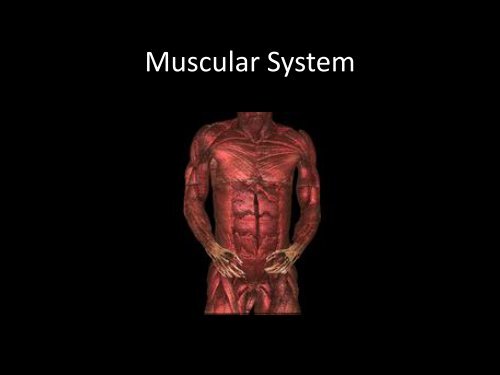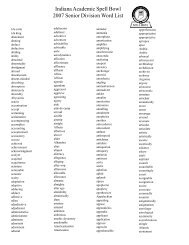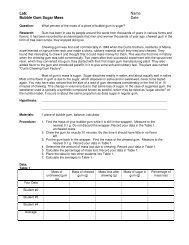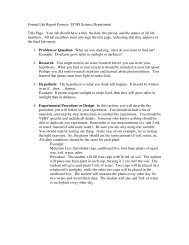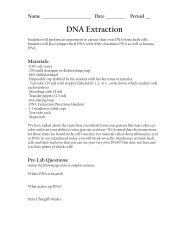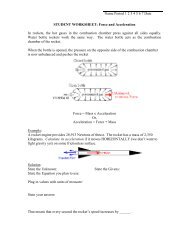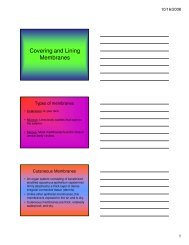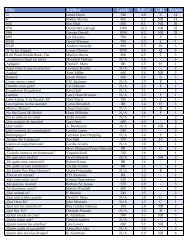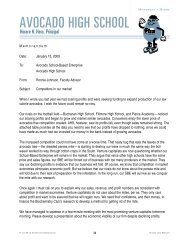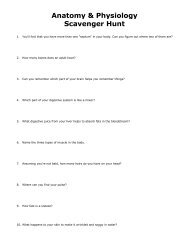Muscular System
Muscular System
Muscular System
Create successful ePaper yourself
Turn your PDF publications into a flip-book with our unique Google optimized e-Paper software.
<strong>Muscular</strong> <strong>System</strong>
Goals<br />
Content: Students will refresh over the<br />
muscular system as well as learn how<br />
muscles get their names (nomenclature).<br />
The students will be able to categorize the<br />
various muscles of the human body based<br />
on their nomenclature.<br />
Language: Students will learn and utilize<br />
correct anatomical vocabulary to describe<br />
and label the different muscle types of the<br />
human body.
Muscle Functions<br />
• Movement<br />
• Protection<br />
• Posture and Support<br />
• Heat
Muscle<br />
• Over 600 muscles<br />
• 40 – 50 % of total body weight<br />
• 215 pairs of muscles<br />
– Aggregate muscle action
Muscle Nomenclature<br />
• Appearance<br />
• Location<br />
• Function
Muscle Nomenclature<br />
• Shape<br />
– Deltoid<br />
– rhomboid
Muscle Nomenclature<br />
• Size<br />
– Gluteus Maximus<br />
– Teres Minor
Muscle Nomenclature<br />
• Number of Divisions<br />
– Biceps Brachii
Muscle Nomenclature<br />
• Direction of fibers<br />
– External Oblique
Muscle Nomenclature<br />
• Location<br />
– Rectus femoris<br />
– Palmaris longus
Muscle Nomenclature<br />
• Points of Attachement<br />
– Coracobrachialis<br />
– Flexor Digitorum Longus
Muscle Nomenclature<br />
Action<br />
– Erector spinae
Muscle Nomenclature<br />
Action and Shape<br />
Pronator quadratus<br />
Action and Size<br />
Adductor magnus<br />
Shape and Location<br />
Serratus anterior
Muscle Nomenclature<br />
Location and Attachment<br />
Brachioradioalis<br />
Location and Number of Divisions<br />
Biceps femoris
Muscle Nomenclature<br />
Groups of muscles<br />
Shape<br />
hamstrings<br />
Number of Divisions<br />
quadriceps<br />
triceps
Muscle Nomenclature<br />
Groups of muscles<br />
Location<br />
peroneals<br />
abdominal<br />
shoulder girdle<br />
Action<br />
hip flexors<br />
rotator cuff
Myofilaments<br />
• Actin – thin proteins<br />
• Myosin – thick proteins
Myofilaments<br />
Sarcomere<br />
Contractile unit of a muscle fiber
What fiber joins muscles to bones?<br />
Tendons
• Flexibility<br />
• Strength<br />
Muscle-tendon Functions<br />
• <strong>Muscular</strong> power<br />
Joints ROM<br />
• <strong>Muscular</strong> endurance<br />
Maximum force on a unit<br />
Rate of muscular force applied<br />
to move a load<br />
Ability of a muscle to exert a<br />
force repeatedly or constantly<br />
Muscle fatigue, soreness, pain – build-up of lactic acid in<br />
the muscles
Structural Damage<br />
in Muscle Fibers<br />
• The vertical lines are the “z -<br />
lines” that define the<br />
boundaries of the muscle<br />
sarcomere<br />
• Microscopic damage can<br />
lead to disruption of the z-<br />
lines and contribute to<br />
soreness
Relative Strength<br />
• The amount of weight lifted relative to the<br />
person's body weight<br />
• Measured as a ratio:<br />
Relative Strength =<br />
weight lifted (lb.)<br />
body weight (lb.)
Fibers and Shape<br />
• Determine a muscle’s ability to exert force<br />
– Cross section diameter<br />
• Greater = greater<br />
• Determine range through which it can exert<br />
force onto the bone it is attached<br />
– Ability to shorten<br />
• Longer muscles shorten through a greater range = more<br />
effective moving joints through large ranges of motion
Classification by Fiber Arrangement<br />
• Parallel<br />
run longitudinally or somewhat<br />
parallel with the muscle’s long axis<br />
• Pennate<br />
(feather-like) tendons run down the<br />
muscle’s long axis, and fibers run obliquely to<br />
the tendon
Parallel Structures<br />
• Fibers are longer<br />
• Run parallel to the length of the muscle<br />
• Pull bones through a greater ROM
• Flat<br />
– Thin and broad<br />
• Fusiform<br />
Parallel Structures<br />
• Rectus abdominus<br />
• External oblique<br />
– Spindle shaped with a central belly that tapers to<br />
tendons on the ends<br />
• Strap<br />
• Brachialis<br />
• Brachioradialis<br />
– More uniform<br />
• Sartorius
Parallel Structures<br />
• Radiate (triangular or fan-shaped)<br />
– Combo of flat and fusiform<br />
• Pectoralis major<br />
• Trapezius<br />
• Sphincter (circular)<br />
– Endless strap around openings<br />
• Orbicularis oris<br />
• Orbicularis oculi
Pennate Structures<br />
• Shorter fibers run oblique to tendons<br />
• Greater cross section = greater force<br />
• Most muscles in the body<br />
• To provide more force than fusiform, but less<br />
ROM<br />
Example: sit-ups
Pennate Structures<br />
• Types<br />
– Unipennate . . . Biceps femoris<br />
– Bipennate . . . Rectus femoris<br />
– Multipennate . . . Deltoid
• Scavenge the room.<br />
Class Activity<br />
• Find something that would be considered<br />
fusiform.<br />
• Find something that would be considered<br />
pennate
Class Activity<br />
• Classify the following items as:<br />
fusiform<br />
unipennate<br />
bipennate<br />
multipennate
Skeletal Muscle Tissue Properties<br />
• Irritability or<br />
Excitability<br />
• Conductivity<br />
• Contractility<br />
• Distensibility or<br />
Extensibility<br />
• Elasticity<br />
responds to nervous stimuli<br />
wave of excitement<br />
pulling ends together<br />
stretched<br />
recoil from a stretch
Reciprocal Inhibition or Innervation<br />
• Agonists<br />
muscles that cause or help cause motion<br />
• Antagonists<br />
perform opposite to the movement being<br />
done<br />
Example: hip flexors & hip extensors
• Synergistic Muscles – same function, work<br />
together
Presentations<br />
You may utilize the following website or any others you find<br />
useful (do not use Wikipedia) to chose a muscle.<br />
http://www.ptcentral.com/muscles/index.html<br />
For the muscle use the internet or other resources to find<br />
the following:<br />
1. State the anatomical and if pertinent the “everyday”<br />
name of the muscle.<br />
2. Identify the muscle’s prime movement if possible<br />
(ex. It is the agonist of flexing the upper arm)<br />
3. State the muscle(s) that is(are) the antagonist(s) for the<br />
muscle’s prime movement.<br />
4. State if there are any synergists acting in conjunction<br />
with the muscle for this action.
Presentations<br />
5. State the muscle fiber arrangement type ( Ex. fusiform,<br />
unipennate, bipennate, or multipennate)<br />
6. State how the muscle received its name or classification.<br />
7. Give an example of a movement that has this muscle<br />
utilizing an isometric contraction.<br />
8. Give an example a movement that has this muscle<br />
utilizing both isotonic contractions (eccentric and<br />
concentric).<br />
9. Make a hypothesis regarding the fiber type this muscle<br />
would most likely have. Also give logical reasoning as to<br />
why you believe this to be so.<br />
10.State a possible “lab” that you could perform to test your<br />
hypothesis in #9.
11. Construct or draw (paint) a figure showing the muscle fiber<br />
arrangement as well as it correct anatomical position.<br />
12. Provide a table that distinguishes the 5 muscle properties<br />
for the muscle by a picture-graph. You may forego the table<br />
and create a slide for each property and picture-graph if<br />
desired.<br />
contractibility<br />
( Ex. )<br />
13. Find or create a video showing the muscle at work<br />
(contracting/extending)


